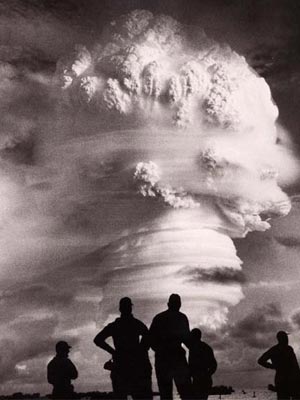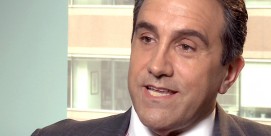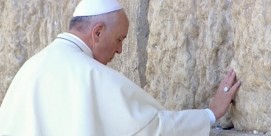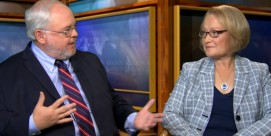Trimming the Nuclear Arsenals
by David E. Anderson
 For much of the past two decades, the issue of nuclear disarmament had faded from public view.
For much of the past two decades, the issue of nuclear disarmament had faded from public view.
Sporadic progress had been made since Ronald Reagan and Mikhail Gorbachev signed the 1991 Strategic Arms Reduction Treaty (START), but as international relations professor Amitai Etzioni argued in a recent article in the World Policy Journal, “While there have been deals aplenty, recent action toward these goals (reduction and elimination of nuclear arms) has been wanting….The hope that nuclear abolition would follow the original Reagan-Gorbachev arrangement lost much of its appeal after the collapse of the Soviet Union.” Etzioni noted that while some reductions in arsenals continued even during George W. Bush’s administration, “dealing with American and Russian weapons lost any sense of urgency.”
Last week’s announcement that the United States and Russia have reached agreements to reduce their nuclear arsenals and that President Obama and his Russian counterpart Dmitry Medvedev will meet in Prague on April 8 to sign to a new treaty that cuts the number of deployed nuclear weapons by 25 percent may change all that. The date of the signing is close to the anniversary of President Obama’s April 5, 2009 address in Prague on nuclear disarmament that has been described by John Isaacs, executive director of the Center for Arms Control and Nonproliferation, as “perhaps the most significant nuclear weapons speech since World War II” and “more important than President John F. Kennedy’s nuclear test ban speech back in the 1960s.”
In mid-January this year, the Bulletin of the Atomic Scientists moved the minute hand of its famous Doomsday Clock from five minutes to six minutes away from midnight, declaring that “we are poised to bend the arc of history toward a world free of nuclear weapons.”
“For the first time since atomic bombs were dropped in 1945, leaders of nuclear weapons states are cooperating to vastly reduce their arsenals and secure all nuclear bomb-making material,” the group said in a statement. “Indeed, we may be at a turning point, where major powers no longer see the value of nuclear weapons for war-fighting or even for deterrence.”
The scientists cited a number of factors, including the election of Barack Obama and a joint letter he and Medvedev issued on April 1, 2009, pledging nuclear weapons cuts and a readiness “to move beyond cold war mentalities”; the bipartisan disarmament drive led by former top US policy makers George Schultz, Henry Kissinger, William Perry, and Sam Nunn (their efforts included the recent documentary film, “Nuclear Tipping Point,” produced by the Nuclear Security Project); and growing participation in the public debate by “a range of civic and religious leaders, including evangelicals, on the role of nuclear weapons in national security.”
Religious groups have been involved in the public conversation about nuclear arms since the first atomic bombs were dropped by the United States on the Japanese cities of Nagasaki and Hiroshima. On August 20, 1945, just days after the bombings, Protestant leaders, most of whom were associated with the Federal Council of Churches, the precursor body of the National Council of Churches, issued a statement expressing their “unmitigated condemnation” of the horrific attacks.
Less than a year later, the Federal Council’s Calhoun Commission, including Protestant theologians Reinhold Niebuhr and John C. Bennett, founders of the journal Christianity and Crisis, issued a more full-bodied report entitled “Atomic Warfare and the Christian Faith” and declared that “we have sinned grievously against the laws of God’” in using nuclear weapons. The report called on the United States to end any further atomic weapons production.
But as David Cortright, director of policy studies at the Kroc Institute for International Peace Studies at the University of Notre Dame, has pointed out recently, a very real ambivalence marked the churches’ response to the bomb. “As the Cold War intensified in the late 1940s, some of those who had greeted the bomb with horror now came to accept it as a necessary deterrent against godless communism and the perceived threat of totalitarian aggression,” he wrote in “Transcending Ambivalence: A History of Enjoying the Bomb,” published in the Spring 2009 issue of Yale Divinity School’s journal “Reflections.” The issue was dedicated to the subject of faith and the future of nuclear weapons.
In the 1980s, however, there was a resurgence of both religious and secular efforts to mobilize in support of nuclear disarmament and to push for an end to the arms race. Most notable were the nuclear freeze movement and the Roman Catholic bishops’ pastoral letter “The Challenge of Peace.” Evangelicals, too, were early opponents of the use of nuclear weapons, including Sojourners, the Christian social justice community, and, from the middle 1980s, the National Association of Evangelicals. More recently, evangelicals have organized the Two Futures Project, a movement of American Christians for the abolition of all nuclear weapons led by the Rev. Tyler Wigg-Stevenson.
The Catholic bishops’ 1983 letter, the product of a special moment in church history created by Vatican II, was significant in a number of ways, not least because it put the nation’s largest religious community squarely in the midst of the public debate over the Reagan administration’s nuclear arms policies. It also challenged the church’s own deep-seated anti-communism and was widely praised for what many regarded as the bishops’ nuanced approach to the nuclear weapons issue. In the letter, the bishops endorsed a “no-first-use” declaration by the United States and voiced support for a comprehensive test ban treaty, both of which continue to be sticky issues in current arms control debates. But they also supported continuing the core policy of deterrence even while making their approval “strictly conditional” and “a step on the way to progressive disarmament.”
Protestant denominations in the United States and international church bodies such as the World Council of Churches, however, pushed beyond the Catholic bishops and the idea of deterrence to hold up an abolitionist vision of a world without nuclear weapons. In 1986, the bishops of the United Methodist Church, for example, published their own pastoral statement, “In Defense of Creation,” which forthrightly rejected deterrence and said the doctrine “must no longer receive the church’s blessing.” Branches of what is now the Presbyterian Church USA also have a long history of opposition to the nuclear arms race, stretching back to 1946. In the 1980s, they endorsed a “Call to Halt the Nuclear Arms Race” and backed “a mutual freeze on the testing, production, and deployment of nuclear weapons.” Over the years, regular Presbyterian statements have continued to follow on arms control and disarmament issues.
As underscored by the Presbyterian statement, the renewed debate in the 1980s paralleled and supplemented developments in the secular arena, especially the nuclear freeze campaign led by the Committee for a SANE Nuclear Policy (now known as Peace Action) and other hybrid secular-religious peace groups.
On the international level, both the World Council of Churches and the Vatican, under a succession of popes, have been outspoken opponents of the arms race and any use of nuclear weapons. Pope John Paul II edged the Catholic Church close to pacifism, declaring there are next to no conditions in a nuclear age that justify nations going to war with each other.
While there had been sporadic arms agreements before, notably the important Nonproliferation Treaty of 1970 and the Strategic Arms Limitation Talks treaty (SALT II) agreement between President Jimmy Carter and Soviet leader Leonid Brezhnev, it was the mounting secular and religious pressures of the 1980s that created the framework for an accord between Reagan and Gorbachev calling for deep reductions in both US and Russian strategic arms. Their agreement resulted in the 1987 Intermediate Range Nuclear Forces Treaty and the subsequent Strategic Arms Reduction Treaty (START I), signed in 1991. A second arms reduction treaty, START II, was signed by George H.W. Bush and Boris Yeltsin in 1992, but it never officially entered into force when the Russians said they would no longer be bound by it after George W. Bush unilaterally withdrew the United States from the Anti-Ballistic Missile Treaty in 2002.
A proponent of nuclear disarmament since his days in the Senate, President Obama quickly made the issue of nuclear disarmament a very visible part of the administration’s agenda. This was most notable in the speech he gave in Prague on April 5, 2009, in which he stated “clearly and with conviction America’s commitment to seek the peace and security of a world without nuclear weapons.” He insisted he was not being naïve in holding up such a vision and acknowledged that it “will not be reached quickly—perhaps not in my lifetime,” but nevertheless with patience and persistence it was an achievable goal.
Obama followed the Prague speech with two other important acts. In July, he and Russian President Medvedev signed an agreement on the basic terms of a treaty to sharply reduce each country’s number of warheads and missiles. In September, he chaired a session of the United Nations Security Council that adopted a resolution to shore up the rules aimed at stopping the spread of nuclear weapons.
On December 5, 2009, the START I treaty quietly expired without a successor agreement in place, and in January, in his State of the Union address, Obama said the US was completing negotiations on what would be “the farthest-reaching arms control treaty in nearly two decades.” Under the terms of what is now being called New START, Russia and the US will cut their warheads to 1,550 on each side within seven years of a new treaty being signed.
But the difficulties presented by both the international negotiations needed to implement and enforce the agreements and the domestic political realities in the United States are not likely to quietly wither in the face of Obama’s soaring rhetoric or aspirations.
Senate approval of New START is expected to present challenges, although the administration says it hopes the deal with Russia will be ratified by the end of this year. As the Washington Post editorialized, “It’s hard to see how new treaties will bring about the disarmament of North Korea or stop Tehran’s centrifuges.” Other skeptical and critical voices are being heard from, some of them asking, as former correspondent William Beecher recently put it, why Obama keeps “waving the flag” of a world without nuclear weapons. “He’s well aware that nations make strategic decisions based on their perceived national self-interest,” Beecher has written. “With so much mistrust in the world, no member of the nuclear club is about to disarm when to do so would make the cheaters the strongest bullies on the block.”
At the moment, the Nuclear Posture Review (NPR), a key statement drawn up by every US administration setting out its basic nuclear doctrine, including the reasoning for retaining nuclear weapons and the circumstances in which they might be used, represents another slipped deadline. The NPR was due to be submitted to Congress on March 1, but a draft version was reportedly rejected by Obama as being merely a “tweaked” version of the Bush administration’s stance, rather than something that would reflect Obama’s nuclear-free aspirations and move much closer to a declaration of “no first use,” making clear the United States would not use nuclear weapons against a non-nuclear nation. The Boston Globe’s Bryan Bender wrote in January that the review “is shaping up to be a major showdown for Obama this year” and that the president was “taking on some of the most sacred cows of the nuclear program.”
“My understanding is that the president and vice president are unhappy with the draft that has been produced,’’ Joseph Cirincione, president of the Plowshares Fund, told the Guardian newspaper on February 28. “Nothing has been settled on the key issue: what is the use for nuclear weapons? This is an issue the president cares deeply about.”
As Obama himself said in his State of the Union address, “Even as we prosecute two wars, we’re also confronting perhaps the greatest danger to the American people—the threat of nuclear weapons. I’ve embraced the vision of John F. Kennedy and Ronald Reagan through a strategy that reverses the spread of these weapons and seeks a world without them. And at April’s nuclear security summit, we will bring 44 nations together here in Washington, DC behind a clear goal: securing all vulnerable nuclear materials around the world in four years, so that they never fall into the hands of terrorists.”
The tug-of- war inside the administration over the critical NPR comes as nuclear arms issues take center stage in the coming months. Along with the April 12-13 global nuclear security summit Obama alluded to, in May the United Nations will hold a conference to review the Nuclear Non-Proliferation Treaty, perhaps the toughest of issues as both Iran and North Korea press ahead with programs for developing their nuclear capabilities, and the nuclear powers are unable so far to come together on a comprehensive negotiating stance for either effort.
Obama is also expected to seek Senate ratification of the Comprehensive Test Ban Treaty (CTBT), which the United States has signed but not ratified. The Senate briefly took up the treaty in 1999 but rejected ratification. The Obama-orchestrated UN Security Council resolution in September 2009 called on all states to refrain from conducting nuclear test explosions and to ratify the CTBT.
For the most part, observes John Isaacs, members of Congress have been very quiet in response to the president on nuclear weapons issues. “The predominant sound from Washington, DC, from Congress, to the president’s proposals has been silence,” Isaacs said in December at the Carnegie Council for Ethics in International Affairs. “The sounds of silence are because nuclear weapons simply are not that popular, and that gives the president…a freer hand than he would have on some other issues.”
Popular or not, it is worth noting that according to a Religion & Ethics NewsWeekly-United Nations Foundation survey in October 2008, controlling nuclear weapons around the world was ranked as the most important US foreign policy priority by 80 percent of respondents. Among Catholics and white evangelicals the percentages were even higher at 82 percent and 86 percent, respectively.
Religious groups are continuing their pressure on Obama—and the rest of the globe—to move toward a nuclear-arms-free world. In February, the Catholic bishops from Hiroshima and Nagasaki, in an open letter to President Obama and the government of Japan, urged world leaders to “take a courageous step toward the total abolition of nuclear weapons and the realization of a world without wars.” In remarks prepared for a recent public forum organized by Georgetown University’s Woodstock Theological Center on “God and the Bomb: Deterrence, Disarmament, and Human Security,” international affairs professor Douglas Shaw observed that “for all the complexity of and disagreement about nuclear weapons, there are some things we know about them. We ought not to live comfortably behind the threat of killing millions of other human beings in an afternoon—because it is morally dubious at best and because it is an unreliable means to guarantee our security.” Woodstock will repeat the forum on April 13 at the Church of St. Ignatius Loyola in New York City.
“The moral end is clear: a world free of the threat of nuclear weapons,” Archbishop Edwin O’Brien of Baltimore, a member of the US Conference of Catholic Bishops committee on international justice and peace, told the Global Zero Summit in Paris in February. “This goal should guide our efforts. Every nuclear weapons system and every nuclear weapons policy should be judged by the ultimate goal of protecting human life and dignity and the related goal of ridding the world of these weapons in a mutually verifiable way.”
“The path to zero will be long and treacherous,” he added. “But humanity must walk this path with both care and courage to build a future free of the nuclear threat.”
David E. Anderson is senior editor for Religion News Service. He has also written for Religion & Ethics NewsWeekly on the war in Afghanistan and on God and empire.







